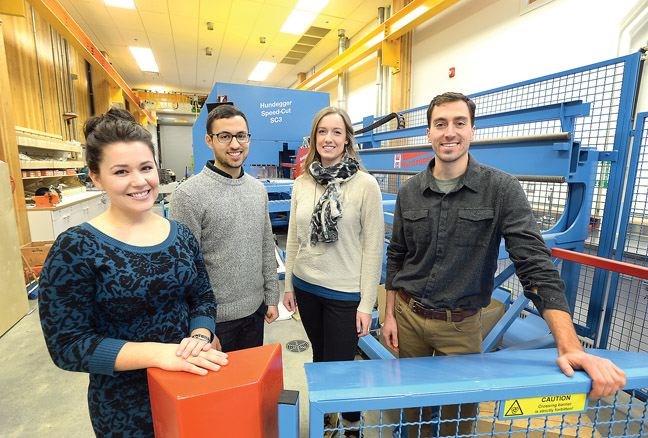For the last two years, Vancouver structural engineer Chelsea Olson has kept her eye on Prince George.
Then the day finally came in September when the University of Northern B.C. opened its applications for the Master of Engineering in Integrated Wood Design.
"Everything just sort of fell in place," said the 26-year-old, who started her first day of classes Tuesday after working with a consulting firm for the past three years.
"I was doing design with concrete, steel, a bit of wood, but I always found the wood projects more interesting."
Growing up in Golden, Olson was surrounded by the material because her father worked as a contractor.
She said wood is desirable for its aesthetic value and a host of other benefits.
"I think it has so many possibilities for the future, for integrating wood in construction. As an engineer it's so easy to revert to steel and concrete construction and it's what most people expect so to try and push the wood construction is a challenge," she said.
"It's completely renewable and it's a direction we should be going as responsible, sustainable engineers. We have the option to make those choices."
On Tuesday, Olson and her three classmates became the UNBC program's first cohort.
"It is a big day for us," said Prof. Guido Wimmers, program lead. ""(It) is a very unique and new program not just in B.C. but across North America. ... Not just the content is unique, but the format is unique because it's a really intensive program."
The one-year graduate degree offers a combination of structural engineering with building physics and sustainability, said Wimmers.
"Our students will be introduced to top-notch and modern engineering with wood as a construction material. That's something a little unique because not too many other universities have that capability," he said, adding students will also be introduced to prefabrication and modern wood manufacturing systems.
Wimmers acknowledged the number of students - four - is "relatively low" in contrast to the university's expressed hope to have 10 students for the inaugural year.
But, he said it was beyond their control. The province approved the program on Sept. 14, one day before the university was supposed to close its admissions. UNBC extended its application deadline, but it left the university with little time to truly recruit.
"I wanted to have more, no question, but at the end we just had five days basically to recruit because of some delays in the process itself," said Wimmers.
It still got 16 applications, two of which deferred to next year and included international students who wouldn't have been able to complete student visas in time.
"We had to make the decision, do we defer it by another year or do we go with what we have and I think sometimes with a brand new graduate program, it's sometimes good to test it with a small cohort and to iron out the kinks and get a big cohort next year," added Kevin Smith, dean of graduate programs.
"We're confident that this student group will grow over the next two to three years tremendously," said Wimmers, who will be teaching with Maik Gehloff, a senior lab instructor from Germany and Asif Iqbal, an assistant professor from New Zealand.
That team includes a technician and the plan is to eventually have five to six faculty.
Most of the students - two from B.C., one from Alberta, one from Montreal - had arrived just days before, so Tuesday offered the first opportunity to step foot in their classroom - the state-of-the-art Wood Innovation and Design Centre.
At 29.5 metres, it's one of the tallest contemporary wood structures in North America.
"The building itself is a showcase and we can introduce and teach students just by looking at the building and various details," said Wimmers, calling Prince George the perfect fit for the program, as "the capital of the forestry industry."
"Bringing a program like this one into P.G makes a lot of sense. We're really introducing the engineers to the next generation of engineering with wood."
Being part of that new way of thinking is what drew David Hanna.
"The program coming up is really refreshing since the construction industry is very conservative and traditional," said the 25-year-old civil engineer. "This program is a good way to physically bring a fresh wave in the industry - much needed fresh wave."



